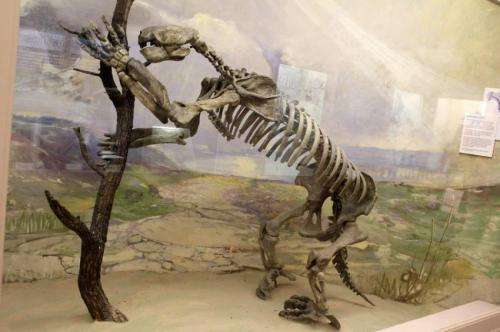June 4, 2014 report
Post ice-age extinctions of large mammals linked to humans, not climate change

(Phys.org) —A team of researchers with Aarhus University in Denmark has concluded that the die-out of large mammals after the last ice-age was due more too human activity than a changing environment. In their paper published in Proceedings of the Royal Society B: Biological Sciences, the team describes how they conducted a country by country survey of all known species extinctions from one thousand years ago to 132,000 years ago. In comparing what they found with known environmental changes during the same period they found a pattern emerging that fingered humans as the main cause of the majority of the extinctions.
As the ice melted at the end of the Pleistocene epoch about 12,000 years ago, large mammals (greater than 10 kilograms) such as the woolly mammoth, the giant sloth, cave dwelling lions, etc. began dying off, eventually disappearing altogether. The cause of the extinctions has, in many cases, been blamed on changing environmental conditions, despite a lack of evidence. In this new effort, the research team has found some evidence to suggest the die-offs were more likely caused by humans—either directly by hunting, or indirectly by burning vegetation needed for survival.
Suspecting that humans were the cause, the researchers conducted a survey of all known species of large mammals that went extinct during and after the Pleistocene epoch. To gain a new perspective they conducted the survey on a country by country basis, rather than by continent as past studies have done. The team then used the data they'd collected to perform a comparative analysis with known weather conditions in the areas where the animals went extinct. In so doing, the team found a pattern emerging—the shorter amount of time that the large mammals lived together with humans, the greater the number of species that went extinct. Put another way, the team found that extinctions were few in Africa where large mammals and humans had existed since the time humans learned to hunt them. More extinctions occurred in Eurasia, but the greatest number by far occurred in the Americas and Australia, where humans arrived later, armed with much better hunting skills.

The researchers even went so far as to calculate the percentages of species extinctions they believe can be blamed on humans—64 percent globally—while only 30 percent could be blamed on fast changing weather patterns (mostly in parts of Europe and Asia).
More information: Global late Quaternary megafauna extinctions linked to humans, not climate change, Proceedings of the Royal Society B, Published 4 June 2014 DOI: 10.1098/rspb.2013.3254
Abstract
The late Quaternary megafauna extinction was a severe global-scale event. Two factors, climate change and modern humans, have received broad support as the primary drivers, but their absolute and relative importance remains controversial. To date, focus has been on the extinction chronology of individual or small groups of species, specific geographical regions or macroscale studies at very coarse geographical and taxonomic resolution, limiting the possibility of adequately testing the proposed hypotheses. We present, to our knowledge, the first global analysis of this extinction based on comprehensive country-level data on the geographical distribution of all large mammal species (more than or equal to 10 kg) that have gone globally or continentally extinct between the beginning of the Last Interglacial at 132 000 years BP and the late Holocene 1000 years BP, testing the relative roles played by glacial–interglacial climate change and humans. We show that the severity of extinction is strongly tied to hominin palaeobiogeography, with at most a weak, Eurasia-specific link to climate change. This first species-level macroscale analysis at relatively high geographical resolution provides strong support for modern humans as the primary driver of the worldwide megafauna losses during the late Quaternary.
Journal information: Proceedings of the Royal Society B
© 2014 Phys.org





















